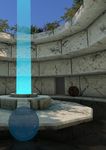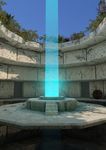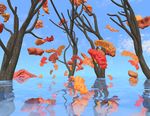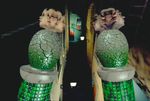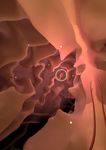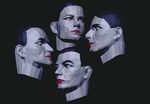Rebecca Allen Sync(Emerge (Consciousness)) - AWS
←
→
Page content transcription
If your browser does not render page correctly, please read the page content below
Introduction In the recent BBC Radio 4 documentary, aired in September 2018, titled The Art of Immersion the American artist Rebecca Allen was introduced as a “pioneer of digital art”. Her work spans over three decades – and beyond that even into the 1970s, beginning with an experimental animation work in 1974 featuring a woman seductively lifting her skirt (more about this in Helen’s Starr’s beautifully crafted and insightful essay that follows this introduction). QUAD’s exhibition programme encompasses much in contemporary art making – particularly photographic and moving-image work – with one of our main focuses is to showcase and champion the very best in digital art (or, more precisely perhaps, art being made today by artists using digital techniques and technology). With this in mind, we are thrilled that an artist of such renown, ability and stature in the field as Rebecca Allen has shared work from her astonishing career with our audiences, as well as producing a brand-new VR commission for QUAD titled Life Without Matter (2018). Rebecca is also QUAD’s International Digital Fellow for 2018 - 2019, joining our roster of other recent high-profile fellows Gibson/Martelli from the UK; teamLab from Japan and the UK/ South Korean partnership Kimchi and Chips (Elliot Wood and Mimi Son). I would like to extend my grateful thanks to Helen Starr – co-curator with me of Rebecca Allen’s exhibition at QUAD – for her support, insights and the exceptional essay that is featured in this publication. Thanks also to my colleagues Laura O’Leary and Bethany Kane for their editing and design of this publication, and to TECH:SQUAD at QUAD for their work installing Rebecca’s exhibition, Sync(Emerge(Consciousness)). My final thanks are reserved for Rebecca Allen; she is indeed a pioneer, and one who continues to pave the way. Peter Bonnell, Senior Curator at QUAD
Sync(Emerge(Consciousness))
Helen Starr
.....Now I do not know whether I was then a man dreaming I was a
butterfly, or whether I am now a butterfly, dreaming I am a man.
莊子 Zhūangzi(c. 369 BC – c. 286 BC)
We are living in the most exciting of times! The future, if such a thing
even exists, will decide if these are the best of times or the worst
of times. And the future/ past as we know it will be written by the
victorious. These are wondrous times for technology, with massive
advances in the last few years in artificial intelligence and virtual
reality. Both of these technologies raise very deep philosophical
issues, such as what is artificial intelligence? Is it an artificial mind?
What is virtual reality? Is it an artificial world?
This is the time of the questing thinker, because philosophy is the
study of the mind and the natural world, and how the two come to
co-exist.
To be able to build artificial minds and artificial worlds will open new
vistas for us because they will make new connections between mind
and world. And if we can connect these two we can build new bridges
to each other. For all other minds and all other bubble worlds – of
artists, of programmers, of farmers and airport workers – are
inhabited by the ‘Other’. And the ‘Other’ is always intrinsically different
from and alien to oneself.
Ordinary physical reality meets three conditions: it is immersive, it is
interactive and it is driven by real world Physics. Film and Music are
Life Without Matter (2018) by Rebecca Allenimmersive, driven by real and/or digital physics but not interactive; Let us consider for a moment that Descartes’ mind-body dualism is an
meeting two of these conditions. Gaming is interactive, driven by digital outdated concept designed to privilege intellect over feeling.
physics but not immersive; it too, meets two conditions. Full-scale ‘Substance’ dualism, as it is commonly known is an old philosophical
virtual reality, of all communication technologies meets three view in which non-physical consciousness has no matter, or that our
conditions, it is an immersive, interactive and computer-generated minds, divorced from our bodies are distinct and separable. This 17th
environment. Virtual reality takes the immersive and interactive quality century thought experiment states that the mental can exist outside of
of everyday reality and brings in the computer to generate the digital the body, and the body cannot think.
physics. We have mostly left this behind as most teenage fans of Kubo’s
manga, Bleach (2001) and Kirkman and Moore’s comics, The Walking
Virtual reality is the ladder over the fourth wall. The fourth wall is the Dead (2003) would agree; that a mind without a body is a ghost and a
conceptual barrier between any fictional work and its viewers or body without a mind is a zombie.
readers. Breaches into this wall can be found as early as Miguel de
Cervantes’ Don Quixote (1605/ 1615) and ‘breaking the fourth wall’ We can apply a more measured approach and embrace instead a
was popularised in the early 20th century by authors such as Virginia term which was introduced in 1972 by Chilean biologists, Humberto
Woolf and C.S. Lewis. It occurs when a character in a fictional world Maturana and Francisco Varela. Autopoiesis (from Greek (auto-), self,
engages directly with his/ her/ their audience; reader, viewer or visitor. and (poiesis), creation) refers to a system capable of reproducing and
The breaking of the fourth wall is often used as a technique to maintaining itself.
increase or decrease immersive aspects of a cultural work. Increased
immersion can trigger mass moral panics and emotional turbulence. Autopoiesis is an astonishing bio-chemical lens which gives us an
Powerful examples include Myrick and Sanchez’s film, The Blair Witch insightful way to look at pioneering artists such as Rebecca Allen,
Project (1993) and Team Salvato’s multiplatform single player visual Suzanne Treister and Hans Haacke who have been thinking about how
novel Doki Doki Literature Club (2017). With flirty, responsive, Lolita- complex systems work in artificial technical environments, in
like avatars who can be wooed by poetry, Doki Doki Literature Club’s sociological environments and in natural, ecological environments.
branching narratives and dark content has elicited warnings from These avant-garde, systems-literate artists laid the fertile ground for
watch-dogs such as The Sun and the BBC. younger, but no less brilliant artists such Pierre Huyghe, Jon Rafman,
Ian Cheng and Anicka Yi.
We can think of virtual reality as an artificial, digital world. When we
digitise ourselves as avatars, when our ephemeral minds inhabit our First among this visionary tribe is Rebecca Allen.
ephemeral bodies, our real bodies react as if we are physically
present. When we are scared in an artificial world, adrenaline (fear) In 1989 Allen wrote “... not only will people build highly detailed artificial
rises in our real bodies, when we feel adoration in an artificial world, worlds in the computer, but they will also create complex characters
our body produces oxytocin (love). The veil, this skin, between what is with ‘human-like’ behaviour that will ‘live’ in these artificial
real and what is virtual is thus compromised and we, in a transitory environments. These new worlds will be experienced by the viewer
state of flux, exist simultaneously in a dreamt-up world and the natural through high resolution displays and the viewer will be able to interact
world. with these synthetic characters.”Like Renaissance artists of old, Allen has always moved fluently
between technology, art and philosophy of mind exploring notions of
feminism, gender fluidity, the body in motion and mind.
Mind (n): the element of a person that enables them to be aware of the
world and their experiences, to think, and to feel; the faculty of
consciousness and thought.
Rebecca Allen’s very first computer animation in 1974 was of a
woman seductively lifting her skirts. Today we can appreciate this as
an insightful critique on patriarchy and the secretiveness of Silicon
Valley Technology. Made despite the then unamused computer
scientists, if only this work had left that sterile computer lab and
passed into the wider world. But things were different then and a
woman’s voice in technology was not allowed above a whisper.
Ten years later in 1984, Kraftwerk (1970 -), pioneers of electronic
music also turned to Allen to create their digital image for the single
Musique Non Stop and to design the cover art for their 1986 album
Techno Pop (aka Electric Cafe). Allen’s Musique Non Stop video went
on to become one of the most lauded MTV videos in pop history.
Furthermore, although Kraftwerk is known for not collaborating with
female artists, Allen’s voice threads through the single, “Musique
nonstop, techno pop, musique nonstop techno pop ...” A lenitive
mantra, now above a whisper; like the rhythmic chant of a 9th century
Gregorian monk.
Allen has collaborated with other world-famous artists such as Korean
American Nam June Paik (1932-2006). In addition to her
Kraftwerk Portrait (1986) by Rebecca Allen collaborations with Paik, she was commissioned by Paik to create the
animations for works such as Office Workers (1992) and Twisted
Turtle (1993) among others. Nam June Paik has been ascribed
accolades such as “founder of video art” and is credited with the
earliest usage of the term “Electronic Superhighway”. His work has
influenced contemporary artists such as Christian Marclay, Cory
Arcangel, Ryan Trecartin and Haroon Mirza.Much of the software, now used by these younger generations of artists was sourced from Allen’s published research. Often the only creative person guiding development of these technologies, many, now ubiquitous software tools were shaped by Allen’s humane, artistic vision. Systems; that animate in three dimensions not two. Systems; that capture how our bodies move in space; like Brancusi’s genre-bending birds. Systems that augment and expand our reality with symbols. Feedback systems that interface using breath, muscles and touch; like a futuristic understanding of Brancusi’s Sculpture for the Blind; Golden Bird (1919). The dazzling, golden bird of Romanian folklore, whose magical song restored sight to the blind and youth to the aged. Allen has always brought her active perceptual thinking to ever current problems such as what does it mean to be a networked, sentient being? How do we navigate our place in this differently ordered modern universe? What are the invisible electrical bonds which tie us not just to our living world and tribal families, but to animals, plants and even artificial beings? All autopoietic creatures; be they human, AI, a swarm of insects or bots or the scented pine forests of the North American landscapes are unified organisations of networked cells. These tangled structures interact and transform continuously in an elemental dance to regenerate the very processes which reproduce and maintain themselves. Let us next get rid of the idea of duality in consciousness. It is not true that there are two sides to consciousness; that you are self-aware, or Laberint (1992) by Rebecca Allen you are not. On/ Off. Fundamental aspects of our conscious mind consist of loosely woven skeins of electrical states existing in a linguistic and cultural framework. Notions such as art and time exist only in an internationally agreed political, cultural and geographical frame. 10.00 am in London is not
the same as 10.00 am in Tokyo and Brancusi’s Bird in Space (1926)
was not a kitchen utensil, but an artwork. Most new and innovative
ideas which seem glaringly obvious now, have been fought for and hard
won. Brancusi v. United States (1928).
So too, do certain woven threads of our consciousness shape the
different parts of our thinking selves.
Brightly lit skeins of our consciousness rise like a wave depending on
the task at hand. We use differently woven fragments for different
situations; for automatic tasks, for quiet wakefulness, for breathing, for
sleeping, for solving hard problems. Neuroscience keeps finding new
skeins and fragments of consciousness and has only very recently
begun to knot them together so as to apprehend the three-dimensional
web of thought.
An understanding of this can be found in two of Allen’s major works
created two decades apart: Life Without Matter (2018) and Bush Soul
(#3) (1999). In Life Without Matter we find ourselves in a mythic space,
a lush forest and the interior of a stone structure that is at once ancient
and futuristic. Built in the innocent, graphical language of the pre-Alpha
Go era, the viewer confronts their digital reflection. And since a virtual
world is immaterial (not built with ‘real’ physics), a virtual mirror need
not reflect one’s physical appearance, but rather the female, male and
animal in all of us. The groundbreaking Bush Soul series (1997-1999)
based on West African Orisha practice allows one to visit the lands of
“Oshun, Goddess of Water and Beauty” and of “Oya, Mistress of
Speed and Tempest”; but, and this is important: as a rider not the
ridden. Both allow you to step into virtual worlds where you can play
with forms of communication that rely on gestures, movements and
artificially intellectualised behaviours.
We, who are transported by these imagined worlds startle as we lose
track of time. When talk turns to losing ourselves in the beat of a drum
or in the high of a hallucinogenic, we now, thanks to Allen’s oeuvre,
have a richer language to describe what we mean. For while our bodies
INSIDE (2016) by Rebecca Allendo not differentiate between the virtual and the real world, our that physical container, our flesh-based mortality. And, in fact, both
consciousness leaves a little fragment to stand guardian of our still works utilise digital images of an actual brain generated using MRI
breathing bodies while allowing other silken strands to extend into this imaging.
dream imagined world, like the long, silken threads that spiders use to
fly. For Allen the role of the body is to act as a vessel for the brain, mind
and conscious self. The brain itself is a vessel for the self-aware mind
Neuroscience continues to develop tools that track this plurality of to understand the makeup of the body through which it feels: love, in
consciousness. When thinking occurs in our brain, it looks like a the racing of heart and fear, in the butterflies of the stomach.
constantly erupting lightning storm that can travel through and across
our brain’s folded surface, travelling tingling to our fingertips and then Though the brain and conscious mind are related, they are not
back again. These constant explosions of electrical activity are our synonyms. They must not be used interchangeably as the brain is the
brain’s cells processing the incessant stream of information coming in complex networked structure within which the mind functions. Without
through our senses. the brain there is no mind.
When we are awake, even when we daydream these bacchanalian Why do we build virtual models of our mind’s eye in our day and night
rhythms exhaust us. So, we seek restoration in sleep. Here our brains dreams? Current thinking suggests that what we dream influences
begin a careful re-ordering so that in REM, sleep becomes more of a what we do and not the other way around. We know that the ability to
summer shower and non-REM sleep settles over us like solitary drizzle. remember the past is linked to the ability of imagining the future. In our
dreamscapes, memory and imagination come to the fore.
Most electric bursts in certain parts of your brain never switch off or
vary when you are awake, daydreaming and dreaming. If they do, you When the brain is not attending fully to the outside world, when you are
are either under an aesthetic or in a coma leaving only the skeins in daydreaming or have recently drifted into sleep, it replays fragments of
charge of our automatic systems lit. These are systems which monitor broken skeins which are parts of old memories in real time. Each
the outside and inside worlds through our senses. They keep you fragment of memory can connect to another in three dimensions, if
breathing, and your heart beating and they startle you to alertness if a there is some commonality between the two. These connectors are
loud sound occurs. When, however, you are not unconscious but specific to a common location, common emotion or a common cue.
asleep or deep in a daydream parts of your brain become active in a And this is how we create a speculative model of the world. Moving
different way and new fragments of consciousness emerge. through these memory models during REM sleep is the way that
consciousness involved in memory and learning attempts to figure out
Allen investigates this thinking through works such as INSIDE (2016) how the past can connect in the future. When we dream, we build
and The Tangle of Mind and Matter (2017). These works, especially future models of the world.
INSIDE (2016) emphasise Allen’s early fascination with the bodily and
the mechanisms that lie within. Allen’s exploration of our most powerful And as these broken skeins compile and recompile they create the
sense, the visual is clearly expressed in the painterly(ness) of INSIDE virtual reality of our mind’s eye.
(2016) and how our mind is embodied in the meat, muscles and sinews
of our tactile self. Both works connect us with our corporeality of being,We create these simulations to prepare us for the future. This is what Beginning with her early anatomical drawings, each subsequent
it means to learn and to adapt our behaviour to new contexts. This is art work has grown in scope and understanding. As Allen’s creative
another trait commonly found in autopoetic creatures; the ability to allegories, her four-dimensional visual poems leapfrog the cascades
dream. of other media which mark our current times, we may finally hope to
understand the Other.
Sentient beings, unlike analogue machines made up of clearly
separate parts cannot be taken apart to be understood fully. Just Like the raised skirt of the early animation, Rebecca Allen’s corpus
as artificially intelligent, digital machines cannot be understood just exposes a philosophical frame that is complex and multi-dimensional
from their graphics cards or electrical plugs. Allen’s body of work and as yet undetermined.
showcases the tangle of tethers, which link the complex parts of
ourselves. We, who are sentient, emerge from our connected selves
and from these nodes of webbed silk, conscious that we are. Cogito,
ergo sum!
When we travel as visitors to Allen’s worlds, we are tethered to the VR
devices, we are tethered to our avatars, we are tethered to our bodies
and to our conscious minds.
Rebecca Allen is an artist who began to generate this type of thinking
in 1974. The more science lifts the skirts and the skins of the hidden,
the more it becomes clear that our brains can only attend to a small
fraction of the surrounding reality. We each inhabit a sensorium, our
own little bubble, which is big enough to get by. This is at the heart of
the struggle to approximate the larger picture.
We can expand our little bubbles, our sensoria by networking ourselves
into the virtual worlds of Rebecca Allen. The fraction of reality we
can understand, can be increased by experiencing virtual reality, it is
expanded by the imagined, virtual world of another. Allen’s thoughtful
dreamscapes allow visitors to explore a virtual space free from
any privilege or lack thereof marked on their bodies as stigma in
the real world. Here, within the imagined space of her mind all who
journey can begin anew. We are no longer as suffocated by ideas of
limited knowledge, of unobtainable information, and of unimagined
possibilities.On Bush Soul by Rebecca Allen
A personal note by Afro-Carib Trinbagonian Helen Starr (2018)
The Great Khan’s atlas contains also the maps of the promised lands
visited in thought but not yet discovered or founded: New Atlantis,
Utopia, the City of the Sun, Oceana, Tamoe, New Harmony, New
Lanark, Icaria.
Invisible Cities, (1972) Italo Calvino
Despite its minor importance in Plato’s work, the story of Atlantis has
had a considerable cultural impact through the ages. From Thomas
More’s
Utopia (1516) to Francis Bacon’s New Atlantis (1627), to James Wan’s
Aquaman (2018), the myth of Atlantis has always portrayed a futuristic
and technologically advanced people.
And so it was over a hundred years ago when German explorer Leo
Frobenius visited West Africa and came across some sculpted bronze
heads and terracotta figures. He was certain, he had discovered
remains of the mythical lost city of Atlantis.
Bush Soul (#3) (1999) by Rebecca Allen
Building on tales long told by Portuguese slavers, Frobenius surmised
that a white civilisation must have existed in Africa and that it was this
“white residue” that enabled native Africans to exhibit traits of “military
power, political leadership and... monumental architecture”.
Frobenius was referring to a West African kingdom of Ife believed to
have flourished from the 12th to the 15th centuries in the lush forests of
the lower Niger, now known as Nigeria. It was in fact, the Yoruba artists
of this kingdom who created the sculptures over the course of some
four centuries. These wondrous artworks are among the mostaesthetically striking and technically sophisticated in the world, layer, could not exist without the underlying two. The third layer
certainly predating anything the British were capable of at that time. emerges as an Extended form of Consciousness. Unlike the first two
Thirty years later, these ancient artefacts forced European historians layers, the third and final layer requires a vast use of conventional
to revise previously held assumptions of an ancient ‘white’ race of memory and as this powerful fragment of consciousness emerges, our
Atlanteans. Eighteen brass and copper sculptures were brought to sense of self moves beyond the here and now.
London and subjected to a more rigorous science-based inquiry using
newly discovered techniques; such as carbon dating. The results Wrapped now in VR cables and tethers Allen’s work extends the
proved compelling. viewers’ consciousness into the richly coloured dreamscape of the
Bush Soul series of works. Here, participants are transported to a
A 1948 article in the Illustrated London News was headlined: “African mythical, equatorial Earth (Ayé) where they are bound to the native
art worthy to rank with the finest works of Italy and Greece” and avatars; as visiting souls. Like the storm borne riders of the Woden’s
“Donatellos of medieval Africa.” folkloric Wild Hunt, viewers can guide their digital steeds to interact
with the fantastical creatures of this world; some with visitor riders and
As critic Michael Glover noted in the UK’s Independent newspaper, “At some without. All who play here are constrained by the programmed,
the same historical moment that Andrea del Verrocchio was doing his scripted behaviours of this digital dreamscape.
wonderfully painstaking, high-Renaissance drawing of a female head,
anonymous artisans in Ife were working with brass, bronze, copper and So too, in Iëre, “The Land of the Hummingbird”, known today as the
terracotta to produce a series of exquisite heads that are not only the Republic of Trinidad and Tobago, storm borne riders (Irunmọlẹ) have
equal of Donatello in technical brilliance, but also just as naturalistic in visited the Orisha shrines which dot the island in scores. When the
their refinement. So much for African primitivism.” drums and chanting of West African descendents reach a crescendo,
women in white clear the way for any devotee who has been chosen to
Rebecca Allen’s series of works Bush Soul (#1, #2 and #3) (1997- be ‘ridden’ by a visiting Spirit (Irunmọlẹ) of the Bush. Trinidad Orisha
1999) is a beautifully researched and exquisitely wrought early virtual deities, equated with Christian saints, are messengers between
reality work which acknowledges the power and importance of the humankind and the divine Kingdom of the Supreme God Olodumare.
West African practice of Orisha.Òrìṣà are the human form of the Oya, Shango’s wife, Mistress of Speed and Tempestuous Wind, is
spirits (Irunmọlẹ) in Yoruba traditional identity. The Irunmọlẹ are meant paired with St Catherine; Oshun, Goddess of Water and Beauty, with St
to guide creation and particularly humanity on how to live and succeed Philomena; Osain, Yoruba God of Herbal Medicine, Healing and
on Earth (Ayé). Prophecy, with St Francis; Ogun, the Warrior God of Iron and Steel, with
St Michael.
Bush Soul (#3), part of the exhibition at QUAD, and its accompanying
VR-like technology invites one to wonder if here, too, in the practice of In Cuban Santeria, Haitian Voodoo and Trinidad Obeah, Orisha
this ancient African race, other invisible, advanced technologies may devotees used the paraphernalia of the Catholic church as
be masquerading incognito. camouflage to hide their African beliefs and practices. Thus, a non-
Christian aural, rhythmic and gestural praxis, continued to be practiced
Bush Soul (#3) flawlessly illustrates neuroscientist Antonio Damasio’s (and is still practiced today) right under the very noses of our colonial
three layered theory of consciousness. In Damasio’s thinking, the final masters.It also happens that, if you move along Marozoia’s compact walls,
when you least expect it, you see a crack open and a different city
appear. Then, an instant later, it has already vanished. Perhaps
everything lies in knowing what words to speak, what actions to
perform, and in what order and rhythm;
Invisible Cities, (1972) Italo Calvino
The Yoruba people have always turned to Orisha practice in times of
social upheaval and sickness. Without hallucinogenic drugs, cables,
software, silicon chips and plastic, the Yoruba people could enact the
most powerful, transportive form of Damasio’s extended
consciousness.
Trinidad Orisha, is in fact a wave based communication tool of the
technologically advanced, ‘Atlantean’ people of West Africa.
More commonly known in the West as Shamanic trance, Shamanic
State of Consciousness (SSC) is a voluntary, self-induced and
temporary state of consciousness that is historically understood to
serve social cohesion and healing interventions in diverse tribal
settings. Brain imaging indicates that shamanic state of
consciousness (SSC) involves a shift from the normally dominant left
analytical to the right experiential mode of self-experience.
As brain imaging technologies become more sophisticated, Western
science is now beginning to understanding the purpose of this powerful
practice which changes the very nature of human awareness.
In 2010, psychologists Dacher Keltner at University of California,
Berkeley and Jonathan Haidt, now at New York University, published a
The Tangle of Mind and Matter (2017) by Rebecca Allen
paper defining a moral, spiritual and aesthetic emotion; awe. “A
subjective feeling rooted in the body,” according to Keltner, where it
erupts through our bristling skin, as goosebumps.
Awe is an emotional response to perceptually vast stimuli that
transcend current frames of reference. Studies show that aweencourages people to endorse more ethical decisions, lower their acoustic instrument invented in the 20th century), in Bele, Kaiso, Soca,
sense of entitlement and report values; in which they pay more Rapso, the chutney of our Carnival and in our Gospel, steady state
attention to the needs of others. castles are woven into our skin. Thus, did we, who are called “The Lost
Tribe of the Yoruba” spread our invisible technology throughout the
At the annual meeting of the Organization for Human Brain Mapping in New World.
Vancouver, Canada, in June 2017, neuroscientist Michiel van Elk
presented functional MRI scans showing that awe produces a Helen Starr is the founder of the not-for-profit organisation The
vanishing self. The egotistical, insecure voice in your head about Mechatronic Library and co-curator of Rebecca Allen’s
self-interest and self-consciousness, disappears. As a result, we feel Sync(Emerge(Consciousness)).
more connected to collectives and groups.
Keltner’s team has also found that weeks later, feeling awe makes
people happier and less stressed and that it assists the immune
system by cutting the production of cytokines, which promote
inflammation. Researchers at Stanford University, California,
discovered that experiencing awe made people feel as if they had
more time and thus were more willing to give up their time to help
others. In addition, boundaries between normally segregated parts of
the brain temporarily break down, boosting creativity and creative
problem solving.
Psychedelic drugs such as Psilocybin and LSD also hijack the natural
system of our mind-body and fast-track people to these experiences
of awe. Virtual reality experiences have been proven to also elicit awe,
so too have the paintings of Caspar David Friedrich, and the
soundtrack Virtual Mima from Satoshi Kon’s Perfect Blue (1997).
There is a growing Western realisation that awe, which is triggered by
being in the presence of a powerful Other has all sorts of benefits for
individuals and society.
So much for African primitivism. With special thanks to Helen Starr’s Mathematical and Computer
Programming Generation Z team: To Harold (Trip) Starr for his meta
Like aural, rhythmic and gestural citadels, the invisible structures of insights into online gaming communities and digital physics. To Chris
West Africa Yoruba covered the landscapes of the New World bringing McGarry on the mechanics of AI modelling. To Jin lei Chen for her
solace, strength and healing to the enslaved community for whom they astute observations on complex digital systems.
were visible. For in the danced drumming of the steel pans (the only www.themechatroniclibrary.com/Biography
Rebecca Allen is an internationally recognized artist inspired by the Helen Starr is an Afro-Carib Trinbagonian cultural activist and founder
aesthetics of motion, the study of perception and behaviour and the of The Mechatronic Library est. 2010. She been programming artists
potential of advanced technology. Her artwork, which takes the form of such as Susan Hillier, Marlene Dumas and Jan Fabre and historical
virtual and augmented reality art installations, experimental video and shows such The Portable Museum of Marcel Duchamp: de ou par
large-scale performances, spans nearly four decades and embraces MARCEL DUCHAMP ou RROSE SELAVY since 1995.
the worlds of fine art, performing arts, pop culture and technology
research. A move away from the commercial sector, saw Starr funding
environmental and artistic digital research projects. In 2008 she
With degrees from Rhode Island School of Design and Massachusetts partnered with the Bartlett School of Architecture, to produce early,
Institute of Technology, Rebecca moves fluidly between artist studio artist designed 3D printed objects in ceramic, silver and bronze. Over
and research lab, using her research to inform her art. Her early 97% of 3D printing uses plastics.
interest in utilizing the computer as an artistic tool led to her pioneering
art involving human motion simulation, artificial life algorithms and A long time patron of South London Gallery, 2013 saw a collaboration
other generative techniques for art creation. She was founding Chair with SLG’s Artists-In-Residence Crabtree and Evans. The result was
of the UCLA Department of Design Media Arts and is currently a Critters (2015) which incorporated game engines and 3D printing;
professor there. a world first.John Eng Kiet Bloomfield’s Worlds Among Us, (2017)
saw partnerships with Wysing Arts Centre, FACT, Liverpool and
Allen’s work is exhibited internationally and is part of the permanent QUAD, Derby leading to feminist VR works such as Warm Worlds and
collection of the Centre Georges Pompidou in Paris and the Otherwise (2018) by Anna Bunting Branch and Life Without Matter
Whitney Museum and Museum of Modern Art in New York. Previous (2018) by Rebecca Allen
collaborators include artists such as Kraftwerk, Mark Mothersbaugh
(Devo), John Paul Jones (Led Zeppelin), Peter Gabriel, Carter Burwell, Helen Starr’s deep hope is to foster an understanding of the digital
Twyla Tharp, Joffrey Ballet, La Fura dels Baus and Nam June Paik. realm. That museums, curators and artists continue to make
beautiful, thoughtful and critical works with these powerful, emerging
www.rebeccaallen.com technologies. So, that they do not belong solely to corporate and
political entities.Rebecca Allen Sync(Emerge(Consciousness)) Published in 2018 by QUAD www.derbyquad.co.uk ISBN 978-0-9954611-6-1 © Rebecca Allen and the authors All images by Rebecca Allen Edited by Laura O’Leary, Bethany Kane and Peter Bonnell Design by Bethany Kane All rights reserved. No part of this publication may be reproduced, stored in a retrieval system, or transmitted at any time or by any means electronic, mechanical, photocopying, recording or otherwise without the prior permission of the copyright holders.
ISBN 978-0-9954611-6-1
You can also read

